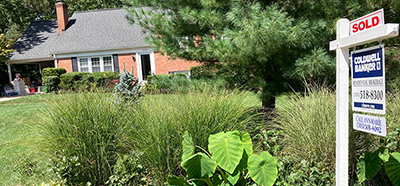
October Existing Home Sales Edge Up 0.8%

Existing home sales rose in October for the second straight month, albeit just slightly, the National Association of Realtors reported Monday.
Total existing home sales (https://www.nar.realtor/existing-home-sales) rose by 0.8% from September to a seasonally adjusted annual rate of 6.34 million in October. Year over year, sales fell by 5.8% (6.73 million). Single-family home sales rose to a seasonally adjusted annual rate of 5.66 million in October, up 1.3% from 5.59 million in September but down 5.8% from one year ago. The median existing single-family home price jumped to $360,800 in October, up 13.5% from October 2020.
Existing condominium and co-op sales fell to a seasonally adjusted annual rate of 680,000 units in October, down 2.9% from 700,000 in September and down 5.6% from one year ago. The median existing condo price rose to $296,700 in October, an annual increase of 8.7%.
Regionally results were mixed. Sales in the Northeast fell by 2.6% in October to an annual rate of 750,000 and fell by 13.8% from a year ago. The median price in the Northeast rose to $379,100, up 6.4% from one year ago. Sales in the Midwest rose by 4.2% to 1,500,000 in October but fell by 6.3% from a year ago. The median price in the Midwest rose to $259,800, a 7.8% jump from October 2020.
Sales in the South increased by 0.4% in October to an annual rate of 2,780,000 but fell by 3.5% from a year ago. The median price in the South jumped to $315,500, a 16.1% climb from one year prior. Sales in the West were unchanged at 1,310,000 in October and fell by 5.1% from one year ago. The median price in the West rose to $507,200, up 7.7% from a year ago.
“Housing demand continues to be held back by insufficient supply,” said Joel Kan, Associate Vice President of Economic and Industry Forecasting with the Mortgage Bankers Association. “It was positive news that home sales increased for the second month in a row and at the fastest pace of sales since January. Similar to MBA’s recent weekly data on purchase mortgage applications, home sales are still running below last year’s elevated pace but have shown some renewed strength recently.”
“Home buying remains intense across most of the country, with the heavy participation of investors and cash buyers making for a very competitive environment,” said Mark Vitner, Senior Economist with Wells Fargo Economics, Charlotte, N.C. “Homes are selling quickly, but price appreciation has moderated somewhat. The inventory of homes available for sale remains exceptionally low.”
“Home sales remain resilient, despite low inventory and increasing affordability challenges,” said Lawrence Yun, NAR chief economist. “Inflationary pressures, such as fast-rising rents and increasing consumer prices, may have some prospective buyers seeking the protection of a fixed, consistent mortgage payment.”
The report said total housing inventory at the end of October fell to 1.25 million units, down 0.8% from September and down 12% from one year ago (1.42 million). Unsold inventory sits at a 2.4-month supply at the current sales pace, equal to September’s supply, and down from 2.5 months in October 2020.
The median existing home price3 for all housing types in October rose to $353,900, up 13.1% from a year ago ($313,000), as prices climbed in each region. This marks 116 straight months of year-over-year increases, the longest-running streak on record.
“Among some of the workforce, there is an ongoing trend of flexibility to work anywhere, and this has contributed to an increase in sales in some parts of the country,” said Yun. “Record-high stock markets and all-time high home prices have worked to significantly raise total consumer wealth and, when coupled with extended remote work flexibility, elevated housing demand in vacation regions.”
The report said properties typically remained on the market for 18 days in October, up from 17 days in September and down from 21 days a year ago. Eighty-two percent of homes sold in October were on the market for less than a month.
First-time buyers were responsible for 29% of sales, up from 28% in September and down from 32% a year ago. Individual investors or second-home buyers purchased 17% of homes in October, up from both 13% in September and from 14% a year ago. All-cash sales accounted for 24% of transactions in October, up from both 23% in September and from 19% in a year ago.
Distressed sales represented less than 1% of sales in October, unchanged from September and a year ago.
